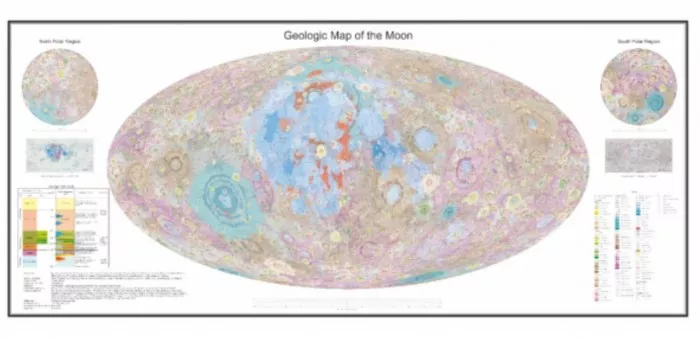On June 9, the reporter learned from the official website of the Chinese Academy of Sciences that under the leadership of Ouyang Ziyuan, an academician of the Chinese Academy of Sciences, and liujianzhong, a researcher of the Institute of Geochemistry of the Chinese Academy of Sciences, the Institute of geochemistry, as the leading unit, has cooperated with Jilin University, Shandong University, the Chinese Academy of Geological Sciences, the China University of Geosciences (Beijing), the Institute of Geographical Sciences and resources of the Chinese Academy of Sciences and other units, based on the data of the Chang'e project in China, By making full use of other international lunar exploration data and research results, and through the study of the "Strata", morphology, composition, structure and geological age of the lunar surface, a new lunar geological chronology is proposed, a division system of impact crater materials, impact basin construction, rock types and structural types is established, and the standards, processes, methods and schematic diagrams for the preparation of lunar geological maps are formulated, The first 1:2.5 million lunar geological map in the world has been completed by using GIS platform.

Source: Institute of Geochemistry
It is understood that on May 30, the lunar geological map results were published online in Science Bulletin.
The lunar geological map system expresses the comprehensive geological information of the lunar crust surface strata, structure, lithology and chronology, and reflects the evolution processes of lunar magmatism, impact events, volcanic activities and so on. The existing lunar geological map is mainly compiled by the US Geological Survey (USGS) based on the Apollo era lunar exploration results. Since the 1990s, human exploration of the moon has achieved rich results and expanded the understanding of the moon, while the preparation of the lunar geological map lags behind. Around 2012, after the exploration and research accumulation of Chang'e-1 and Chang'e-2, China gradually has the conditions and foundation to carry out the compilation and research of the lunar geological map.
According to the introduction, in the newly compiled lunar geological map, the lunar geological chronology is updated based on the understanding of the dynamic evolution process of the moon. The lunar surface history is divided into three eras - the styrozoic (magmatic ocean), the paleolunar (Aiken, Jiuhai and Yuhai) and the crescent (elatosonian and Copernican), and the stages dominated by internal dynamic geological processes in the evolution process of the moon The stage in which both internal and external dynamic geological processes are emphasized corresponds to the stage in which external dynamic geological processes are dominant.
The elements expressed in the geological map mainly include: 12341 impact pits, of which 7548 impact pits identify and express pit materials, and 4793 impact pits are represented by annular structures; 81 impact basins, and their basin formations are identified and expressed; There are 17 rock types, including 5 types of lunar basalt (very low titanium, low titanium, medium titanium, high titanium and very high titanium basalt), 7 types of non lunar basalt (ferrous anorthosite, ferrous norite, magnesian anorthosite, magnesian suite, alkaline suite, Kreep rock, Kreep basalt) and 5 types of special rock outcrops (pure anorthosite, spinel anorthosite, peridotite rich rock, pyroclastic rock and siliceous volcanic rock); 14 types of structures, of which 10 types of structures of internal dynamic origin include 16839 linear structures and 364 ring structures, and 4 types of structures of external dynamic origin include 2137 linear structures and 4874 ring structures; The drawing also expresses some special elements, such as landing points, special elevation points, etc.
It is reported that this 1:2.5 million lunar geological map comprehensively expresses the lunar geology and evolution information, which can provide important basic data for lunar scientific research, exploration planning, landing site location, etc., and provide reference for the preparation of other astrogeological maps. The 1:2.5 million geological map of the whole month is compiled in both Chinese and English, and is published in both paper and electronic versions by the Geological Publishing House. It also includes the structural outline map and rock type distribution map of the whole month.